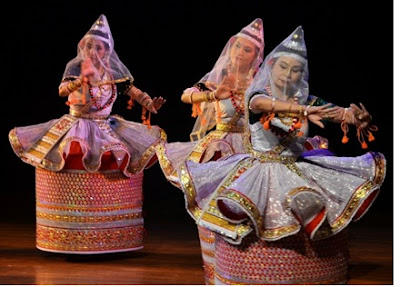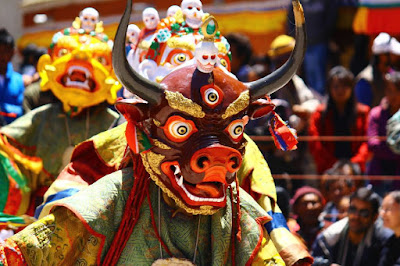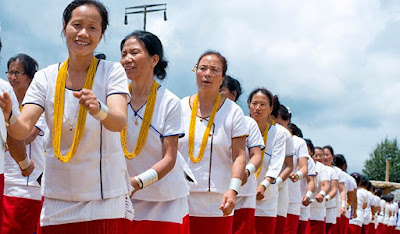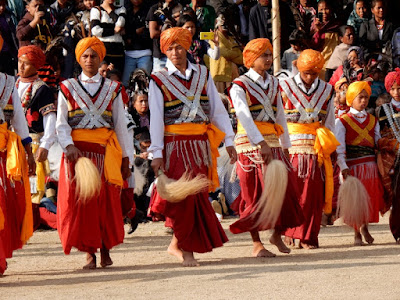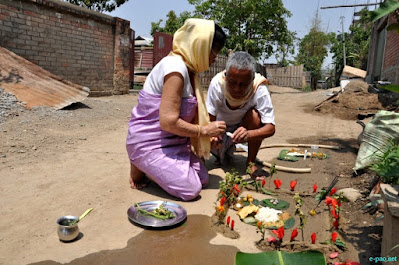Festivals in Northeast India are generally very different from the rest of India. Northeast India is a home of various ethnic groups and tribes and practices different traditions.
Thus they show different forms of festivals which represent their unique culture and traditions. Traditional Festivals in northeast India are not only associated with traditional dances and singing, but also have some great rock music concerts in these festivals as well.
Don't be confused if you see a rock concert on the program list. Just have a local made rice beer (every tribe has a different name of their local beer) and enjoy. There are more than 100 traditional festivals celebrated amongst the tribes of Northeast India, but these 17 traditional festivals of Northeast India are unique and certainly most popular amongst locals and tourists.
List of Famous Traditional Festivals in Northeast India
Bihu Festival, Assam
Hornbill Festival, Nagaland
Wangala Festival, Meghalaya
Myoko Festival, Arunachal Pradesh
Losoong or Namsoong Festival, Sikkim
Sangai Festival, Manipur
Chapchar Kut, Mizoram
Kharchi, Tripura
Aoling Festival, Nagaland
Mopin Festival, Arunachal Pradesh
Moatsu Festival, Nagaland
Bhumchu Festival, Sikkim
Dree Festival, Arunachal Pradesh
Torgya Festival, Arunachal Pradesh
Nongkrem Dance Festival, Meghalaya
Cheiraoba Festival, Manipur
Karbi Youth Festival, Assa
1. Bihu Festival, Assam
Bihu is the chief festival in the Assam state of India. It refers to a set of three different festivals: Rongali or Bohag Bihu observed in April, Kongali, or Kati Bihu observed in October, and Bhogali or Magh Bihu observed in January.
The Rongali Bihu is the most important of the three, celebrating the Assamese new year and the spring festival. The Bhogali Bihu or the Magh Bihu is the one that is all about food.
The Kongali Bihu or the Kati Bihu is the somber, thrifty one reflecting a season of short supplies and is an animistic festival.
Bihu is a traditional festival where people cook traditional meals using rice and wear traditional clothes.
Dance and music form an important part of the celebration and the festivities continue for seven days at a stretch. The entire festival is extremely secular in nature and is deeply connected with agriculture.
2. Hornbill Festival, Nagaland
The Hornbill Festival of Nagaland is one of the biggest cultural extravaganzas in the North East. It is a week-long event held every year from Dec1-10 in Nagaland.
The Hornbill Festival is a festival to revive, protect, sustain, and promote the richness of the Naga heritage and traditions.
The Festival is named after the hornbill, the globally respected bird and which is displayed in folklore in most of the state’s tribes.
3. Wangala Festival, Meghalaya
Wangala Festival of Meghalaya which is also known as the “100 Drum Wangala Festival” is an enchanting winter festival. Practiced traditionally by the Garos, it is the annual harvest festival of Meghalaya and is celebrated in the honor of Misi Saljong, The Great Giver.
Wangala Festival signifies the beginning of winter and also marks the end of labor in fields ushering in a period of relaxation and merry-making.
Wangala is traditionally celebrated for two to three days - or up to a week - by two or three collaborating villages; though recently it has been celebrated for one day in metropolitan areas as an attempt to conserve the ancient heritage of the Garo tribe and to expose the younger generation to their roots.
True traditional styles of celebrating Wangala can be found in remote "Songsarek" (animistic) villages such as Sadolpara in West Garo Hills district of Meghalaya.
Where people who worship the old gods still persist in their way of life; all the while rejecting Christianity.
A much more hyped and commercialized variant of Wangala can be observed in the 100 Drums Festival held at Asanang in West Garo Hills, Meghalaya, where performers (who may or may not be Christians and not Songsarek) are invited from all over Garo Hills, and even from far off places such as Karbi Anglong, Tripura and Bangladesh which has sizeable pockets of Garo inhabitants.
This mega event is held for three days and is a host to various fan favorites such as sports, food, art, and culture.
4. Myoko Festival, Arunachal Pradesh
 |
| courtesy-swantour |
One of the most impressive festivals of the Apatani in Arunachal is Myoko. It is celebrated in spring.
In it, age-old beliefs in the possibility of attaining and directing fertility to the fields and the people are interwoven with methods of strengthening family, clan, and inter-village ties.
This festival falls on March 20 and continues for 10 days i.e. this year it will fall on March 20 and will end on March 30, 2018.
This festival is celebrated in Ziro which is situated in Arunachal Pradesh. Every year this festival is celebrated by the Apatani tribe of Arunachal Pradesh.
This festival lasts for 10 days. This festival of Arunachal Pradesh is mainly celebrated in the Spring season. The people who celebrate this festival worship the Sun and Moon and all the natural things.
5. Losoong or Namsoong Festival, Sikkim
Losoong or Namsoong is the Sikkimese New Year, of the Bhutia tribe, celebrated every year in the month of December. Based on the Tibetan Lunar Calendar, Losoong falls on the 18th day of the 10th month, when farmers celebrate the harvest.
It is a traditional festival of the Bhutias, but the Lepchas also celebrate it and call it Namsoong.
The festival has been adapted from the traditions and rituals of the Tibetan New Year, Losar. The festival is conducted at the Phodong and Rumtek Monasteries in Sikkim.
6. Sangai Festival, Manipur
Sangai festival is an annual cultural festival organized by the Manipur Tourism Department every year from 21 to 30 November. Even though many editions of this Festival have been celebrated over the past few years with the name of Tourism Festival.
Since 2010 this has been renamed as the Sangai Festival to stage the uniqueness of the shy and gentle brow-antlered deer popularly known as the Sangai Deer, which is the state animal of Manipur.
As this festival is being celebrated to promote Manipur as a world-class tourism destination, it showcases the state's contributions to art and culture, handloom, handicrafts, fine arts, indigenous sports, cuisine, music, eco and adventure sports, as well as the natural environment.
7. Chapchar Kut, Mizoram
The Chapchar Kut is a festival of Mizoram, India. It is celebrated during March after completion of their most arduous task of jhum operation i.e., jungle-clearing.
It is a spring festival celebrated with great fervour and gaiety. Oral traditions say Chapchar Kut was first celebrated in Seipui village in adjoining Myanmar that has a sizable population of Mizos and their ethnic cousins.
Chapchar Kut used to be celebrated to thank the gods for saving the people from harm during the clearing of forest on hill slopes for jhum cultivation at the beginning of a year. The festival used to be observed with a lot of drinking and eating.
On the first night, the young men and women would dance all night. The women would come dressed wearing a Vakira. Chai dance has its origins in this festival.
8. Kharchi, Tripura
The Kharchi festival has still linked the past with the present. It is said that this festival or puja was commenced by the royal family of Tripura when the capital of princely Tripura was at Old Agartala.
Now it is a universal festival that sees the confluence of people of different walks of life. Only head images of fourteen deities are worshipped during Kharchi.
The government has come up with helping hands by sponsoring this festival since the last several years. Not only religious worship and prayer, but cultural programs also become its attractions during festival days falling in July.
9. Aoling Festival, Nagaland
The Aoling Festival is a festival celebrated by the Konyak Naga people and held in the first week of April in the Mon district of Nagaland, North East India.
The Aoling Festival differs from the Hornbill Festival as it is an authentic tribal festival arranged by the Konyak tribe only. The celebrations for the Aoling Festival are spread across a week.
The main purpose of the Aoling Festival is to welcome in the spring and New Year and to pray for a good harvest.
During the Aoling Festival, many rituals take place including dancing, feasting and sacrifices that are meant to appease the divine spirits in order to bless the land with a good harvest.
10. Mopin Festival, Arunachal Pradesh
The Mopin Festival is an agricultural festival celebrated by the Galo tribe of Arunachal Pradesh, India in particular of the Galo group of tribes that reside in East Siang and West Siang districts.
It is a celebration of the harvesting season held in the Galo months of "Lumi" and "Luki", corresponding to March–April and the new year for the Galo tribe. The Galo tribe follows an animist religion called Donyi-Polo.
The Mopin Festival is believed to bring wealth and prosperity to all households and to the whole community. The rituals associated with celebrating the Mopin festival drive away evil shadows and bring blessings, peace, and prosperity for all mankind.
The main Goddess worshiped during the festival is called Mopin Ane. She is as important to the Galos as the Goddess Lakshmi is to Hindus, and is believed to bring in fertility and prosperity.
11. Moatsu Festival, Nagaland
Moatsu festival is celebrated in the first week of May every year. Various rituals are performed during this period. The Aos observe Moatsü Mong after the sowing is done.
The festival provides them a period of recreation and entertainment after the stressful work of clearing fields, burning jungles, sowing seeds, cleaning up the Tsubu (wells) and repairs and construction of houses by elders of the Putu Menden, stretching over a week.
The Moatsu festival is marked by peppy songs and dances.The whole festival full of merrymaking and fun is observed only for three days from May 1 to 3.
The natural customary practice of the forefathers was competing in making the best rice-beer and rearing the best possible pigs and cows to be slaughtered during the festival.
The women weave the best of traditional garments and adorn themselves with all their finery. They join the men in dancing, eating and drinking and composing warrior songs. Singing songs in praise of the lover and the village as a whole is done and the older men encourage the young people to be bold and heroic to defend and protect them from enemies as head-hunting was practiced during their forefather's time.
12. Bhumchu Festival, Sikkim
Bhumchu means Bhum is a pot, Chum is water is a Buddhist festival, which on the Tibetan lunar calendar is held on the 14th and 15th day of the first month, which is between February and March on the Gregorian calendar.
The Bhum or Sacred vase, according to Zigpo Lingpa, is made out of various kinds of sacred soil, water and five kinds of precious jewels found in sacred lands of India, Odiyana and Zahor.
In Sikkim the Tashiding Monastery is recognized as a sacred place. It is believed that this place, Dakkar Tashiding in the center of four sacred caves, Sharchog Bephug in the east, Khandozangphu in the south, Dechenphug in the west and Lhari Nyingphug in the north, is meant to free you from the suffering of hell.
At the start of the year the vase is opened and the Lama or monk determines the future. “If the water is to the brim, it foretells a year in which peace and prosperity will prevail.
If the water is over the brim and is spilling, it signifies a year with natural disaster and disturbances. If the water level is low or almost dry it signifies famine.” The celebration of “The Holy Water Vase” started under the rule of King Trisong Deutsonin Tibet, Guru Padmasambhava.”
13. Dree Festival, Arunachal Pradesh
The Dree Festival of Arunachal Pradesh is an agricultural festival celebrated by the Apatani tribe of Arunachal Pradesh. The Dree Festival is the biggest festival of the Apatanis and celebrated with zest marked by sacrificial offerings and prayers.
In olden days the Dree was observed on different days according to the convenience of the concerned 'Dree Goras' or 'Pantangs' (an organising committee at village level).
It could not be called a festival in a true sense, rather it was a ritual performed by the Apatanis. However, Dree Biisi (traditional folk song) amongst the girls, and games and sports like wrestling, high jumps, etc. amongst the boys took place in the village level though they were not on a large scale as it is today. Now it is the biggest festival in the Apatani valley, which is celebrated at other places as well wherever the Apatanis live.
14. Torgya Festival, Arunachal Pradesh
Torgya, also known as Tawang-Torgya, is an annual festival that is exclusively held in Tawang Monastery, Arunachal Pradesh, India.
It is held according to the Buddhist calendar days of 28th to 30th of Dawachukchipa, which corresponds to 10 to 12 January of the Gregorian calendar, and is a Monpa celebration.
The objective of the festival is to ward off any kind of external aggression and to protect people from natural disasters.
15. Nongkrem Dance Festival, Meghalaya
The Nongkrem dance festival is celebrated during autumn at Smit, the cultural center of the Khasi Hills.
A five day long religious festival of the Khasis, Ka Pemblang Nongrem dance is popularly known as Nongkrem dance Similar to all other festivals of the Meghalaya, Nongkrem Dance Festival is performed to appease the all-powerful Goddess Ka Blei Synshar for a rich bumper harvest and the prosperity of the people.
16. Cheiraoba Festival, Manipur
During the Cheiraoba festival, special festive dishes are prepared which are first offered to various deities.
Celebrated during the month of April, a part of the ritual entails villagers climbing the nearest hill tops in belief that it will enable them to rise to greater heights in their worldly life.
Spring cleaning activities will be seen in all the families of the Meitei people prior to the festival. They will clean all things, including clothes, utensils, all household items, unused items around the house, etc. It is also traditional to buy new clothes to wear for the New Year.
17. Karbi Youth Festival, Assam
Karbi Youth Festival is an annual festival celebrated by the Karbi People of Assam. It is celebrated on 15–19 February of every year in Taralangso, Diphu, Karbi Anglong District.
It is locally called Riso-Nimso Rong Arje. Karbi Youth Festival is one of the largest cultural celebrations in the North-eastern part of India. Every year, visitors are able to sample delectable Karbi cuisine, enjoy music and dance performances and purchase authentic Art and crafts.





